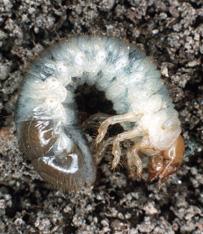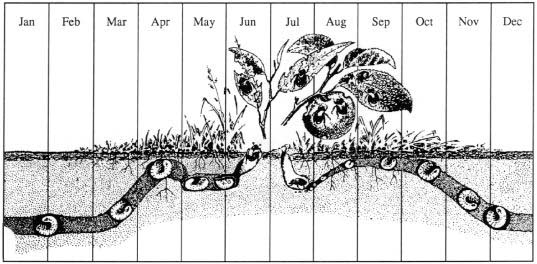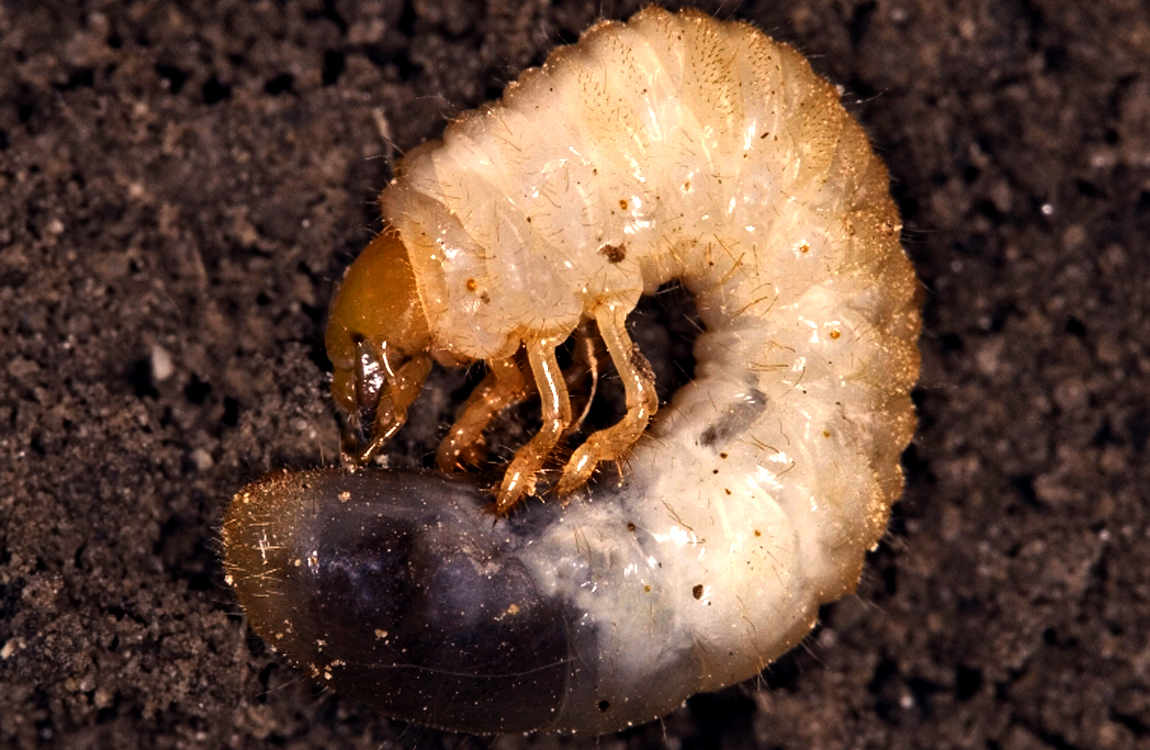Every year we get a flood of questions regarding grubs in lawns. What do you do and when do you do it to rid yourself of these pests?
You always see the damage caused by white grubs in the spring. Of course human nature dictates that we feel obliged to do something the moment we see the resultant damage. When dealing with insects, though, once you see the damage, it's usually too late.
First, let's take a look at the insect itself. White Grubs in our area are typically the larvae of the Japanese Beetle or the June Beetle. They appear in the ground as a white worm-like insect with a dark tail end. When removed from the soil or disturbed, they form a curled "C" shape. In the early spring, grass can often be lifted like sod. Crows, skunks, and raccoons often make a mess of the remaining lawn as they dig in the ground looking for grubs to snack on.

Now let's take a look at the life-cycle of the white grub.

Here we really get a good idea of what's happening with the grubs during the year. The grubs visible in the spring are at the largest larvae stage. They come closer to the surface of the soil after the winter dormant period and do a little munching on grass roots. The damage seen in the spring, however, is the damage from the previous year. The appetite of the grubs in the spring is relatively minor and grass can typically survive this limited damage an April. The grubs then begin to pupate in the soil as plants start to grow. The adult beetle then emerges from the soil around June. At this point the adult beetle can become an annoyance in the garden, though it's effects are less of a problem in our regions than the larvae is. After feeding for a time, the adult beetle then lays her eggs back in the soil and those eggs hatch in June/July. This is the point where grubs are most susceptible to various control methods. For the rest of the summer the larvae feed on grass roots and grow. They burrow down deep into the soil for the winter and thus the cycle repeats.
Because lawns are actively growing when grubs do most of their damage, we typically don't see problems in our lawns during the summer or the fall. The grubs end up weakening the plant enough that winter survival of the grass is comprised which is why we see all the damage in the spring.
The "adult" larvae is difficult to kill. It needs lots of chemicals to do the job and the window to actually do something in the spring is very short. In general, it's best to ignore the grubs in the spring and instead concentrate on getting your lawn back into shape. That means spreading some more grass seed to re-establish a good healthy lawn.
Once June and July arrive, it's time to try and deal with those newly hatched grubs. In Ontario, we have very few options left for grub control. Well, effectively one: Nematodes - a microscopic worm that seeks out grubs and kills them. Products like GrubOut (water based Sevin) or commercial products (like Merit) are banned as of April 22, 2009.
Nematodes are a fussy bunch of bugs. A small package can contain up to 50 million of these worms. They get diluted in water and are applied with a hose end sprayer. Their effectiveness is not 100% but it is typically effective enough to strike enough of a balance that the grub population is reduced to the point your lawn suffers little to no damage. However, there are some rather specific conditions to nematodes. First, the soil needs to be 15 degrees Celsius or else they will die. Second, they travel in water so they need lots of water to get into the ground. Third, they are killed by ultra-violet light from the Sun. With all these conditions, it makes Nematodes sound rather difficult. My suggestion with Nematodes: Stand out in the rain on a warm June day and water your lawn with Nematodes. You look like a dork, but it covers off all the conditions - the soil it warm, mother nature is providing water, and you don't often get sun and rain together. It's not a perfect solution, but it seems to be the best option for the home-owner.
Grub control is more preventative than anything. If there have been grub problems in your neighbourhood, I highly suggest the dorky Nematode application annually in June.
And one last bit of advice - a healthy plant gets less bugs. Keep your lawn good and healthy and you will have less chances of getting problems.

